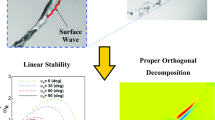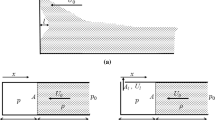Abstract
In the present study the velocity profiles and the instability at the interface of a two phase water-oil fluid were investigated. The main aim of the research project was to investigate the instability mechanisms that can cause the failure of an oil spill barrier. Such mechanisms have been studied before for a vast variety of conditions (Wicks in Fluid dynamics of floating oil containment by mechanical barriers in the presence of water currents. In: Conference on prevention and control of oil spills, pp 55–106, 1969; Fannelop in Appl Ocean Res 5(2):80–92, 1983; Lee and Kang in Spill Sci Technol Bull 4(4):257–266, 1997; Fang and Johnston in J Waterway Port Coast Ocean Eng ASCE 127(4):234–239, 2001; among others). Although the velocity field in the region behind the barrier can influence the failure significantly, it had not been measured and analyzed precisely. In the present study the velocity profiles in the vicinity of different barriers were studied. To undertake the experiments, an oil layer was contained over the surface of flowing water by means of a barrier in a laboratory flume. The ultrasonic velocity profiler method was used to measure velocity profiles in each phase and to detect the oil–water interface. The effect of the barrier geometry on velocity profiles was studied. It was determined that the contained oil slick, although similar to a gravity current, can not be considered as a gravity current. The oil–water interface, derived from ultrasonic echo, was used to find the velocity profile in each fluid. Finally it was shown that the fluctuations at the rearward side of the oil slick head are due to Kelvin–Helmholtz instabilities.











Similar content being viewed by others
References
Amini A (2007) Contractile floating barriers for confinement and recuperation of oil slicks. PhD thesis, No. 3941, Ecole Polytechnique Fédérale de Lausanne
Amini A, De Cesare G, Schleiss AJ (2006) Interface tracking and velocity profile in an oil–water two-phase flow. In: Fifth international symposium on ultrasonic Doppler methods for fluid mechanics and fluid engineering, ISUD 5, Switzerland, pp 125–128
Amini A, Kantoush SA, Schleiss AJ (2008) Velocity field measurements in the vicinity of an oil spill barrier using LSPIV method. In: International conference on fluvial hydraulics, River Flow, Turkey (accepted)
Benjamin TB (1968) Gravity currents and related phenomena. J Fluid Mech 31:209–248
Britter RE, Simpson JE (1978) Experiments on dynamics of a gravity current head. J Fluid Mech 88(2):223–240
Brouwers JJH (2007) Dissipation equals production in the log layer of wall-induced turbulence. Phys Fluids 19(10)
Chandrasekhar S (1961) Hydrodynamics and hydromagnetic stability. Oxford
De Cesare G, Schleiss A (1999) Turbidity current monitoring in a physical model flume using ultrasonic doppler method. In: Second international symposium on ultrasonic Doppler methods for fluid mechanics and fluid engineering, Switzerland, pp 61–64
Delvigne GAL (1991) On scale modeling of oil droplet formation from spilled oil. In: 12th international oil spill conference
Drazin PG, Reid WH (2004) Hydrodynamic stability, 2nd edn. Cambridge University Press, Cambridge
Fang F, Johnston AJ (2001) Oil containment by boom in waves and wind. III: Containment failure. J Waterway Port Coast Ocean Eng ASCE 127(4):234–239
Fannelop TK (1983) Loss rates and operational limits for booms used as oil barriers. Appl Ocean Res 5(2):80–92
Lee CM, Kang KH (1997) Prediction of oil boom performance in currents and waves. Spill Sci Technol Bull 4(4):257–266
Lee LT, Langevin D, Farnoux B (1991) Neutron reflectivity of an oil–water interface. Phys Rev Lett 67(19):2678–2681
Leibovich S (1976) Oil slick instability and entrainment failure of oil containment booms. J Fluids Eng Trans ASME 98(1):98–105
Lyons RG (2004) Understanding digital signal processing, 2nd edn. Prentice Halle PTR, Upper Saddle River
Met-Flow (2002) UVP-DUO User’s guide, Release 5, Met-Flow SA, Lausanne, Switzerland
Milgram JH, Van Houten RJ (1978) Mechanics of a restrained layer of floating oil above a water current. J Hydronautics 12(3):93–108
Nakamura H, Kondo M, Kukita Y (1996) Simultaneous measurement of liquid velocity and interface profiles of horizontal duct wavy flow by ultrasonic velocity profile meter. In: First international symposium on ultrasonic Doppler methods for fluid mechanics and fluid engineering, Villigen, Switzerland, pp 29–32
Nakamura H, Kondo M, Kukita Y (1998) Simultaneous measurement of liquid velocity and interface profiles of horizontal duct wavy flow by ultrasonic velocity profile meter. Nuclear Eng Des 184:339–348
Schlichting H, Gersten K (1999) Boundary layer theory. Springer, Heidelberg
Shin JO, Dalziel SB, Linden PF (2004) Gravity currents produced by lock exchange. J Fluid Mech 521:1–34
Simpson JE (1972) Effects of the lower boundary on the head of a gravity current. J Fluid Mech 53(4):759–768
Simpson JE (1997) Gravity Currents: in the Environment and the Laboratory, 2nd edn. Cambridge University Press, Cambridge
Simpson JE, Britter RE (1979) The dynamics of the head of a gravity current advancing over a horizontal surface. J Fluid Mech 94(3):477–495
Takeda Y (1995) Velocity profile measurement by ultrasonic doppler method. Exp Therm Fluid Sci 10(4):444–453
Trallero JL, Sarica C, Brill JP (1996) A study of oil–water flow patterns in horizontal pipes. In: SPE annual technical conference, Denver, USA, pp 363–375
Von Karman T (1940) The engineer grapples with nonlinear problems. Bull Am Math Soc 46:615–680
Wicks M (1969) Fluid dynamics of floating oil containment by mechanical barriers in the presence of water currents. In: Conference on prevention and control of oil spills, pp 55–106
Willemetz JC (1996) Influences of fixed and moving interfaces in the measurement of velocity profiles. In: First international symposium on ultrasonic Doppler methods for fluid mechanics and fluid engineering, Villigen, Switzerland, pp 63–66
Xu Q (1992) Density currents in shear flow- a two-fluid model. J Atmos Sci 49(6):511–524
Xu Q, Moncrieff MW (1994) density current circulation in shear flows. J Atmos Sci 51(3):434–446
Zha GC (2004) Boundary-layer loss mechanism and assessment of wall function for turbulence modeling. AIAA J 42(11):2387–2390
Acknowledgments
The research project is financed by the Swiss Petroleum Union under grant No. 4’09’02. The authors express their appreciation to Prof. Dr. Y. Takeda for his helpful comments on the measurements and data analysis, and to Met-Flow for providing technical support. The two anonymous reviewers are also greatly acknowledged for their detailed and useful comments.
Author information
Authors and Affiliations
Corresponding author
Rights and permissions
About this article
Cite this article
Amini, A., De Cesare, G. & Schleiss, A.J. Velocity profiles and interface instability in a two-phase fluid: investigations using ultrasonic velocity profiler. Exp Fluids 46, 683–692 (2009). https://doi.org/10.1007/s00348-008-0594-1
Received:
Revised:
Accepted:
Published:
Issue Date:
DOI: https://doi.org/10.1007/s00348-008-0594-1




